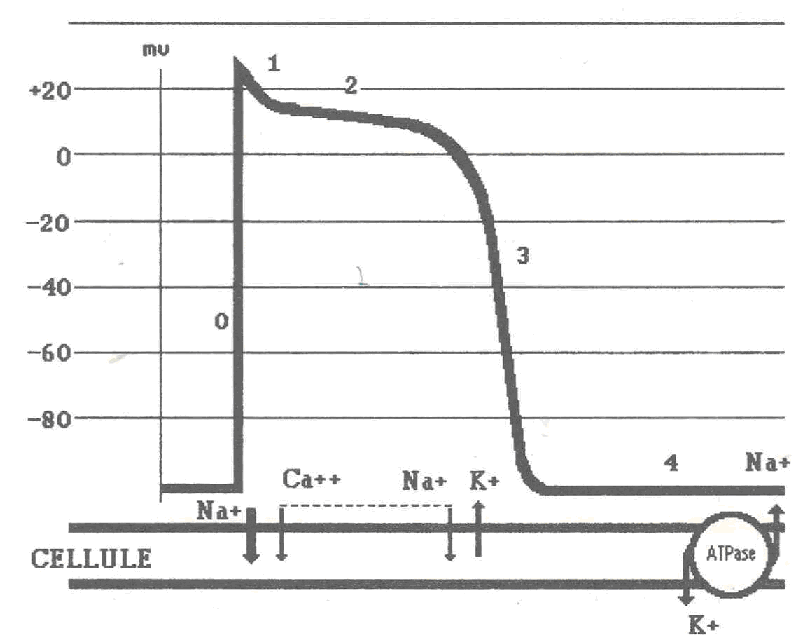1- Classification of Vaughan Williams:
* Class I: sodium channel inhibitors (+ membrane stabilizing effect)
– Ia: quinidine; disopyramide (Rythmodan)
– Ib: lidocaine; phenytoin; mexiletine
– Ic: Cibenzoline, propafenone (Rythmol®) flecainide
* Class II: Beta-blockers
* Class III: inhibitors of potassium flux
– Amiodarone (Cordarone)
– Sotalol (Sotalex®)
– Bretylium
* Class IV: calcium channel blockers
– Verapamil (Isoptine)
– Diltiazem (Tildiem®)
– Bepridil
2- Action Sites:
* Atrioventricular node: Class II; Class IV; digitalis
* Atrial Ventricular Myocardium &: class Ia and Ic.
* Ventricular myocardium: Class Ib
* Atrial Ventricular Myocardium & & atrioventricular node: Class III; propafenone (Rythmol)
3- Amiodarone:
A- Indication:
– Adjustment of AF, flutter or atrial tachysystole
– Preventive or curative treatment of ventricular arrhythmias
– Arrhythmias WPW syndrome
– Preventive treatment of angina
B- cons-indications:
Sinus node dysfunction
– AVB II or III unaided
– Thyroid Dysfunction; iodine allergy
– Association with drugs that prolong the QT.
C- Side effects:
– Hepatitis
– Thyroid Dysfunction
– Interstitial lung disease
– Peripheral neuropathy
– Torsades de pointes
– Other: photosensitivity, reversible corneal deposit
4- Class I:
A- quinidine:
1- Indications:
– Prevention of recurrence fibrillation or flutter after return to sinus rhythm
– Prevention of paroxysmal supraventricular tachycardia crises
– Treatment and prevention of ESA and ESV
2- Side effects:
– Idiosyncrasie fever, hypotension, QT prolongation
– Effect proarythmyque: torsade de pointes, BAV, BSA, ESV
– Dizziness, deafness, tinnitus
B- Lidocaine:
1- Indications:
Correction and prevention of ventricular arrhythmias in the acute phase of MI.
2- adverse drug effects:
– Neurological: tremor, confusion, convulsion
– Hypotension, bradycardia
5- General characteristics:
A- Class Ia:
– Increases the duration of PA
– QT high (risk TDP)
– Widening of the QRS
– Flattening of the T wave
– Negative inotropic effect
– Act sue the atria and ventricles.
B- Class Ib:
– Reduction of the duration of PA
– Unchanged ECG
– Unchanged inotropic
– Exclusive ventricular Action
C- Class Ic:
– Enlargement of QRS with a possible BB
– Unchanged QT
– Negative inotropic effect
– Action in the atria and ventricles.
D- Amiodarone:
– Increased the duration of the AP and refractory periods.
– QT elevation; the sinus rate decreases; PR increases; T wave flattening; U wave
– Do not change the inotropic
– Action at all levels
6- Associations:
A- prohibited Associations:
– Two AA of the same family
– II + IV
– III + IV
B- AF or flutter Prevention:
– Ia + digoxin
– Ia + beta blocker
C- Preventing recurrence TV:
Amiodarone + beta blocker


Leave a Reply